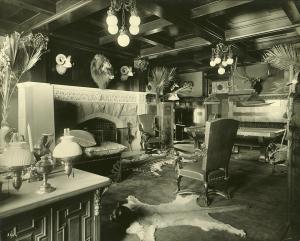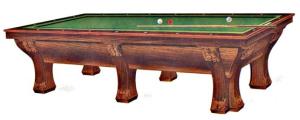Preparing an Historic Inn for the Season
The Inn has opened for its 28th season! Every year, in preparation, we compile, scrutinize, evaluate and prioritize the many “to do” projects related to conserving and preserving the Inn’s historic finishes and furnishings. With 24 bedrooms and additional public rooms filled with items original to the house, the lists are never short!
Critical planning for many of these projects happens a year or more before any work begins. Whenever possible, we consult Shelburne Farms’ rich archival collections — historic photographs of interiors, correspondence, bill books (1890s through the 1920s), and a detailed household inventory (ca. 1915) — to guide our decisions.
Annually preparing the house for the season takes many people with many talents. Fortunately, we can call on a group of expert local conservators and craftsmen who help us shepherd our historic resources.
Here’s a peek at a few projects we undertook for the 2015 season.
Overlook: Carpeting, bed, curtains
Brown Room: Wallpaper
The 1915 household inventory noted that a “Wall paper [sic] striped pink and green with roses and light blue bow knots” was used in the room. But when we went looking for wallpapers at the Boston Design Center, we couldn’t find a sample that incorporated all those elements. After much consideration, we selected a Zoffany wallpaper called Oak Garland, which is based on an 18th century document from Temple Newsam, a Jacobean mansion in Leeds, United Kingdom.
The talented John Plant and his son Dan removed the old wallpaper and hung the new. John comes from a line of experienced painters and wallpaper hangers, including his father and grandfather. (His brother Bob works at the front gate!) John Plant is old school. He believes every job should be perfect, because his name is on it!
Game Room: Pool Table
The billiard table in the Game Room looms large in my mind: It weighs 2100 lbs, sits directly above the Archives (and my desk!), and has been in that location now for 114 years. It has required two years of off-season restoration.
Three years ago some of the billiard tables 6 leather pockets were failing. Several pool table restorers suggested replacing them with new “old” looking ones, but that just didn’t feel right. At about the same time, I happened to meet Greg Hunt at a New England Carriage Association meeting. Hailing from Mayville, Wisconsin, he turns out to be an absolute whiz at repairing and replicating harnesses, saddlery, coach interiors, and other leather goods. Greg was thrilled to help us. He is pretty game to tackle anything, keeping repairs to a minimum and his work undetectable. Tom Gardner, our Cheese Operations Manager, shipped the pockets safely to Wisconsin, and Greg got to work.
We also had to recover the table. For this, I selected a Championship Invitational Teflon in “English Green”. Unlike the typical championship green, this green is much more sympathetic to the color of the felt pictured in the 1898 catalogue (see image).On February 10 (it was a balmy 18 degrees), Brunswick reps from Pool World (Burlington, VT) came to measure the table for an estimate for re-covering it. Seeing the table for the first time, Kyle and Mark loved it! They returned on April 8th to begin the work.
Now, after two years of careful craftsmanship, the table is in great shape!
Marble Dining Room: Silk repair
Preserving the historic integrity of Shelburne Farms, a National Historic Landmark, in order that we can share it with visitors is exciting and inspiring work. And to do it in service to the Farm's wider mission of educating for sustainability is even more gratifying. Thank you for supporting us. If you make it to the Inn this season, stop by the Archives for a visit!






